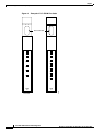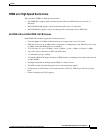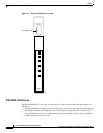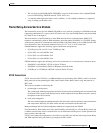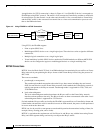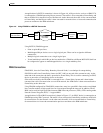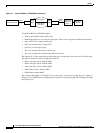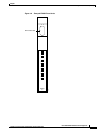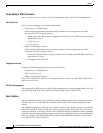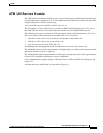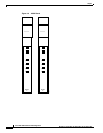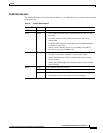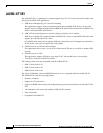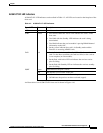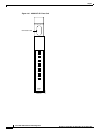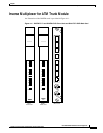
4-16
Cisco MGX 8220 Installation and Configuration
Release 5.0, Part Number 78-6430-03 Rev. D0, November 2003
Chapter
Frame Relay Service Modules (FRSMs)
Frame Relay to ATM Conversion
The conversions are cell loss priority (CLP), Congestion Indication, and PVC Status Management.
Cell Loss Priority
Cell loss priority mapping is provided in both directions.
• Frame Relay–to–ATM Direction
Each Frame Relay/ATM network interworking connection can be configured as one of the
following DE to CLP mapping schemes:
–
DE bit in the Frame Relay frame is mapped to the CLP bit of every ATM cell generated by the
segmentation process.
–
CLP is always 0.
–
CLP is always 1.
• ATM–to–Frame Relay Direction
Each Frame Relay/ATM network interworking connection can be configured as one of the
following CLP to DE mapping schemes:
–
If one or more ATM cells belonging to a frame has its CLP field set, the DE field of the Frame
Relay frame will be set.
–
No mapping from CLP to DE.
Congestion Indication
Congestion Indication mapping is provided in both directions.
• Frame Relay–to–ATM Direction
EFCI is always set to 0.
• ATM–to–Frame Relay Direction
If the EFCI field in the last ATM cell of a segmented frame received is set, then FECN of the Frame
Relay frame will be set.
PVC Status Management
The management of ATM layer and FR PVC Status Management can operate independently. The PVC
status from the ATM layer will be used when determining the status of the FR PVCs.
User Interface
The command-line interface (CLI) permits the adding, configuring, deleting, and displaying of lines,
channels, and ports on a FRASM card. In addition, the counters on the card can be displayed and
cleared.
The FRASM command set permits the user to create protocol groups. Protocol groups are specified as
either STUN, BSTUN, BNN, or BAN types. When a group has been created, ports and routes can be
assigned as members of the group. Groups can be configured, displayed, and deleted. These commands
affect the entire group thus permitting a number of ports to be configured with one command rather than
having to configure each individually. Details of the CLI and individual commands are found in the
Cisco MGX 8220 Command Reference.



